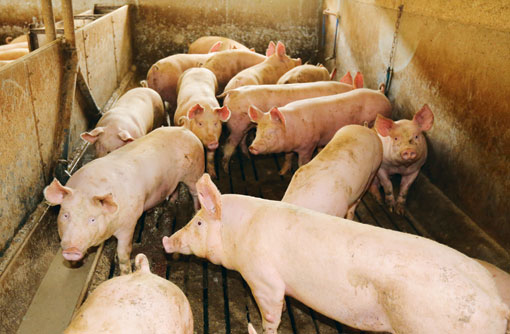Pig producers face a challenging start to 2013

A combination of arctic weather, high feed costs and falling pig values have already presented UK pig producers with a tough start to the new year.
With an estimated 40% of the breeding herd now kept on outdoor systems, the recent spell of winter weather has added to straw usage rates as well as the problems associated with providing drinking water in freezing conditions and higher feed consumption rates.
Indoor units are also faced with increased energy costs to keep farrowing houses and piglet areas warm, while dealing with the hazards caused by burst pipes and sub-zero temperatures.
Feed costs
Animal feed is the single largest expense involved in pig production and according to the BPEX, this has increased from 50% of the total cost in 2007 to 66% in late 2012.
Ex-farm feed wheat was trading between £206/t and £210/t early this week, which represents a rise of almost 40% over the past 12 months.
For those producers with wet feed systems and access to co-products, significant savings can be made, despite the need to formulate a suitably balanced ration from a wide range of available ingredients.
Co-ops and buying groups are also another way in which groups of 10 or more local farmers can pool their resources and gain significantly more purchasing power buying their ingredient in bulk, as well as looking at hedging opportunities on the futures markets.
Feed additives may also be worth looking at, as these can enhance gut health, and include yeast-based products, essential oils, herbal extracts, probiotics, enzymes and organic acids.
Self-operated mill and mix systems do, however, need careful supervision as well as the services of an experienced and skilled nutritionist to ensure that productive rations can be formulated on a least-cost basis.
As a result of high feed costs, weaner values have remained below cost of production levels with the AHDB 30kg ex-farm average for the first three weeks in January at £46.29 a head compared with production costs of about £50 a head.
Imports and exports
Reports are being received of rising levels of EU mainland pigmeat imports undercutting the domestic market at a time when the average EU producer price is equivalent to 135p/kg compared with the UK Deadweight Adjusted all Pigs Price (DAPP), of 159.84p/kg for the week ending 19 January.
Further evidence of falling EU mainland pigmeat prices has also been indicated by the sharp fall in cull sow values, 90% of which forms the basis of UK pigmeat exports to Europe.
UK cull sow export prices have fallen to a two-year low and are averaging 93p/kg deadweight compared with 114p/kg a year ago. This is equivalent to a loss in value of about £30 a head.
UK producers are hoping that the recent rise in low-priced pigmeat imports will soon cease once the effects of the EU mainland partial stall and tether ban, which became law on 1 January this year, are felt.
Sow stall ban compliance
According to figures released by the National Pig Association (NPA), with the exception of Austria, Estonia, Luxembourg, Sweden and the UK, which are all fully compliant with the ban, other EU mainland pig production countries have a long way to go to match this.
French units are only 33% compliant, compared with 45% in Belgium, 48% in Germany, 50% in the Republic of Ireland, 63% in the Netherlands, 69% in Italy, 70% in Spain, and 80% in Poland.
As a result the NPA is calling for a policy of zero tolerance towards retailers, importers, food manufacturers and caterers who import product that is in breach of the ban, which should help to stimulate demand for UK pigmeat across the range.
Red Tractor
The recent disclosure that unlabelled horsemeat and pork products have found their way into economy burgers being sold by some of the major food chains, including Tesco, should also add weight to the NPA’s campaign for retailers and consumers to support the British pig industry.
It also underlines claims that the Red Tractor symbol provides a ready indication that not only is the product sourced in the UK, but also meets the highest farm assurance standards.
NFU president Peter Kendall also added that all retailers needed to engage better with Red Tractor assurance by increasing the use of the logo at point of sale, which would also increase consumer confidence, confirming the integrity of all UK farm-produced products that would be easily distinguishable and clearly labelled.
